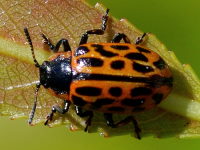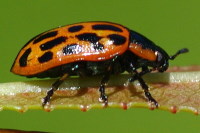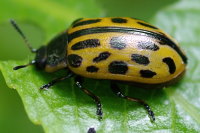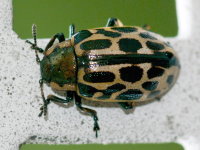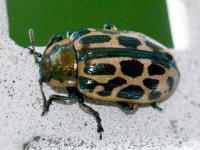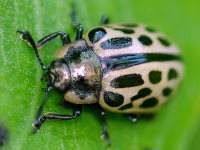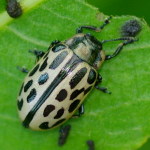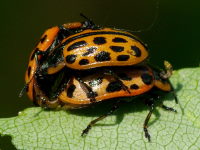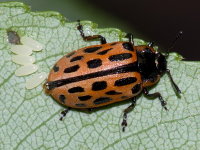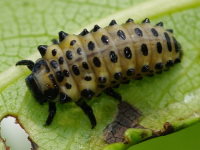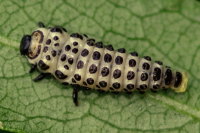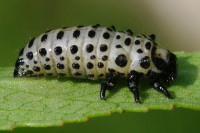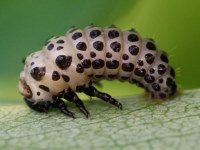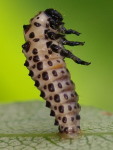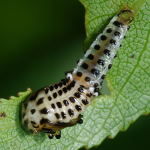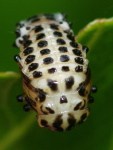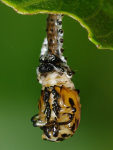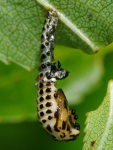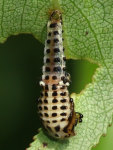Phylum Arthropoda (Arthropods) ➔ Subphylum Hexapoda (Hexapods) ➔ Class Insecta (Insects) ➔ Order Coleoptera (Beetles) ➔ Family Chrysomelidae (Leaf beetles)
Chrysomela (Strickerus) vigintipunctata (Scopoli, 1763)
Gefleckter Weidenblattkäfer Spotted Willow Leaf Beetle
Synonyms and other combinations:
Coccinella vigintipunctata Scopoli, 1763 | Melasoma vigintipunctata (Scopoli, 1763) |
Classification:
Chrysomela vigintipunctata belongs to the subfamily Chrysomelinae, tribe Chrysomelini.Distribution:
Sweden, Central, Eastern and Southeastern Europe, east to East Asia.Habitat:
Almost always near water bodies - on some willow species.Description:
Length 6.5 - 8.5 mm; elytra with black suture, each with 10 black spots and variable basic colouring (whitish, yellow, orange, red); pronotum very narrow in relation to the elytra, with black centre and lateral edges in the same colour as the elytra; head and underside metallic black; tibiae on the outer edge only towards the tip with a clear groove.Larvae light with black spots.
Biology:
The Spotted Willow Leaf Beetle Chrysomela vigintipunctata forms one generation per year.The airworthy adults are active from April to August. They emerge from hibernation in April and search for suitable host plants. The oligophagous species lives on some willow species (Salix, Salicaceae). Both the imagines and the larvae feed on the leaves of their host plants. The larvae go through 4 larval stages in up to 2 months. To moult, they hang on a leaf with their hind end and pupate later in a similar position. The pupal period lasts about 7 - 10 days. The beetles of the new generation hatch already in June/July, eat for 3 weeks on their host plants and then go into a long autumn and winter diapause. The adults spend the winter in protected places in the foliage layer or under bark.
Chrysomela vigintipunctata can proliferate locally and defoliate some trees.
Natural enemies:
The tachinid fly Cleonice callida Meigen, 1824 (Diptera, family Tachinidae).Some chalcid wasp species (Chalcidoidea) - Schizonotus sieboldi (Ratzeburg, 1848) and Schizonotus latus (Walker, 1835) (family Pteromalidae), and Tetrastichus melasomae Graham, 1991 (family Eulophidae).
References, further reading, links:
- Rheinheimer, Joachim, & Hassler, Michael: Die Blattkäfer Baden-Württembergs, 2018, 928 pages, Kleinsteuber Books (Karlsruhe), ISBN 978-3-9818110-2-5
- Arved Lompe: Die Käfer Europas - Ein Bestimmungswerk im Internet
- Agelastica alni
- Altica sp.
- Aphthona nonstriata
- Bromius obscurus
- Bruchus rufimanus
- Bruchus sp.
- Cassida nebulosa
- Cassida rubiginosa
- Cassida sp.
- Cassida stigmatica
- Cassida vibex
- Cassida vibex/bergeali
- Cassida viridis
- Chrysolina fastuosa
- Chrysolina haemoptera
- Chrysolina hyperici
- Chrysolina lucidicollis
- Chrysolina oricalcia
- Chrysolina sp.
- Chrysolina sturmi
- Chrysolina varians
- Chrysomela populi
- Chrysomela tremula
- Chrysomela vigintipunctata
- Clytra laeviuscula
- Clytra quadripunctata
- Coptocephala sp.
- Crepidodera aurata
- Crepidodera aurea
- Crepidodera fulvicornis
- Crioceris duodecimpunctata
- Cryptocephalinae sp.
- Cryptocephalus moraei
- Cryptocephalus nitidus
- Cryptocephalus pusillus
- Cryptocephalus sp.
- Donacia bicolora
- Donacia cinerea
- Donacia marginata
- Donacia versicolorea
- Galeruca tanaceti
- Galerucella s.l.
- Gastrophysa viridula
- Gonioctena decemnotata
- Gonioctena quinquepunctata
- Gonioctena quinquepunctata/intermedia
- Gonioctena sp.
- Gonioctena viminalis
- Lema cyanella
- Leptinotarsa decemlineata
- Lilioceris lilii
- Lochmaea caprea
- Neocrepidodera ferruginea
- Neocrepidodera sp.
- Oulema melanopus/duftschmidi
- Oulema obscura
- Pachybrachis sp.
- Phratora sp.
- Phratora vitellinae
- Phyllobrotica quadrimaculata
- Phyllotreta armoraciae
- Phyllotreta nemorum
- Phyllotreta vittula
- Plagiodera versicolora
- Plagiosterna aenea
- Plateumaris sp.
- Podagrica fuscicornis
- Psylliodes sp.
- Pyrrhalta viburni
- Sphaeroderma sp.
- Xanthogaleruca luteola
